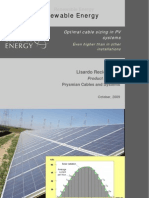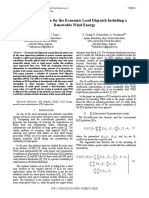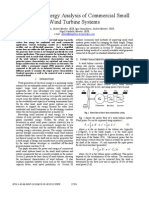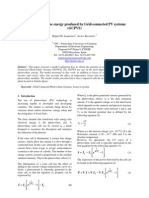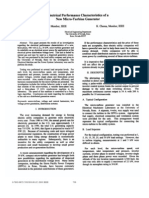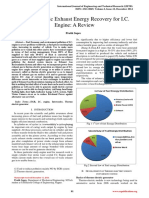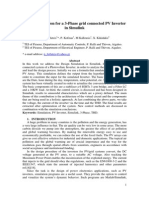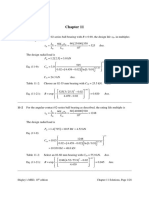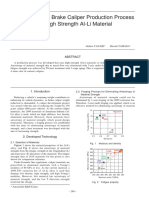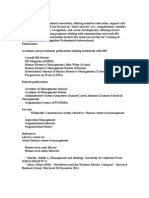Leonardo SPEA
Leonardo SPEA
Uploaded by
Mikael Mitch LanzoniCopyright:
Available Formats
Leonardo SPEA
Leonardo SPEA
Uploaded by
Mikael Mitch LanzoniCopyright
Available Formats
Share this document
Did you find this document useful?
Is this content inappropriate?
Copyright:
Available Formats
Leonardo SPEA
Leonardo SPEA
Uploaded by
Mikael Mitch LanzoniCopyright:
Available Formats
Leonardo Journal of Sciences
ISSN 1583-0233
Issue 14, January-June 2009
p. 204-220
http://ljs.academicdirect.org
204
Economic Dispatch for Power System included Wind and Solar Thermal
energy
Saoussen BRINI, Hsan Hadj ABDALLAH, and Abderrazak OUALI
ENIS, Dp. Gnie Electrique, 3038 Sfax, Tel.:74 274 088
E-mails: ingenieurbrini@yahoo.fr, hsan.haj@enis.rnu.tn, abderrazak.ouali@enis.rnu.tn
Abstract
With the fast development of technologies of alternative energy, the electric
power network can be composed of several renewable energy resources. The
energy resources have various characteristics in terms of operational costs and
reliability. In this study, the problem is the Economic Environmental
Dispatching (EED) of hybrid power system including wind and solar thermal
energies. Renewable energy resources depend on the data of the climate such
as the wind speed for wind energy, solar radiation and the temperature for
solar thermal energy. In this article it proposes a methodology to solve this
problem. The resolution takes account of the fuel costs and reducing of the
emissions of the polluting gases. The resolution is done by the Strength Pareto
Evolutionary Algorithm (SPEA) method and the simulations have been made
on an IEEE network test (30 nodes, 8 machines and 41 lines).
Keywords
economic dispatch, total cost, active losses, multi objectives optimization,
evolutionary algorithms, SPEA, renewable energy
Introduction
The economic and environmental problems in the power generation have received
considerable attention. The apparition of the energy crisis and the excessive increase of the
Economic Dispatch for Power System included Wind and Solar Thermal energy
Saoussen BRINI, Hsan Hadj ABDALLAH, and Abderrazak OUALI
205
consumption have obliged production companies to implant renewable sources. However, this
production poses many technical problems for their integration in the electric system.
The economic dispatch [8, 16] is a significant function in the modern energy system. It
consists in programming correctly the electric production in order to reduce the operational
cost [4, 7, 10, 15]. Recently, the wind power and solar thermal power attracted much attention
like promising renewable energy resources [1, 6, 11, 18, 19, 22].
The problem is formulated as a multiobjective optimization problem [3, 5, 9, 24, 25].
It consists in distributing the active and renewable productions between the power stations of
the most economic way, to reduce the emissions of the polluting gases and to maintain the
stability of the network after penetration of renewable energy. The number of decision
variables of the problem is related to all the nodes of the network.
Renewable energy
In this study, it is interested in two types of energies; wind power and thermal solar
energy.
Wind energy
The mechanical power recovered by a wind turbine can be written in the form [6, 17,
23]:
3
w
V .
2
p
R . . .
p
C
2
1
w
P = (1)
where C
P
, is the aerodynamic coefficient of turbine power (it characterizes the aptitude of the
aerogenerator to collect wind power), is the air density, R
p
the turbine ray and V
W
wind
speed. The power coefficient value C
P
, depends on the rotation speed of turbine and wind
speed.
Mechanical adjustment of the wind power
Wind turbine is dimensioned to develop a nominal power P
n
from a nominal wind
speed V
n
. For wind speeds higher than V
n
, the wind mill must modify these aerodynamic
parameters in order to avoid the mechanical overloads, so that the power recovered by the
turbine does not exceed the nominal power for which the wind mill was designed.
Leonardo Journal of Sciences
ISSN 1583-0233
Issue 14, January-June 2009
p. 204-220
206
n
P
n
V
D
V M
V
1 2 3 4
w
P
w
V
Figure 1. Diagram of the useful power according to the wind speed.
According to the figure1, the characteristic of power according to the wind speed
comprises four zones. Zone 1, where P
w
= 0, zone 2, in which useful power depends on wind
speed. V
w
, zone 3, generally where provided power P
w
remains appreciably equal to P
n
and
finally zone 4,P
w
= 0
Solar energy
Solar energy is energy produced by the solar radiation, directly or in a diffuse way
through the atmosphere. Thanks to various processes, it can be transformed into another form
of useful energy for the human activity, in particular in electricity or heat [14, 17, 23].
The maximum power provided by a solar panel is given by the following characteristic
[14, 17]:
)] T T .( P 1 .[ E . P P
jref j 2 c 1 S
+ =
(2)
E
c
is solar radiation, T
jref
is the reference temperature of the panels of 25C, T
j
is the cells
junction temperature (C), P
1
represent the characteristic dispersion of the panels and the
value for one panel is included enters 0.095 to 0.105 and the parameter P
2
=-0.47%/C; is the
drift in panels temperature [14].
The addition of one parameter P
3
to the characteristic, gives more satisfactory results:
) E P )].( T T .( P 1 .[ P P
c 3 jref j 2 1 S
+ + =
(3)
This simplified model makes it possible to determine the maximum power provided by
a group of panels for solar radiation and panel temperature given, with only three constant
parameters P
1
, P
2
and P
3
and simple equation to apply.
A thermal solar power station consists of a production of solar system of heat which feeds
from the turbines in a thermal cycle of electricity production.
Economic Dispatch for Power System included Wind and Solar Thermal energy
Saoussen BRINI, Hsan Hadj ABDALLAH, and Abderrazak OUALI
207
Formulation of problem
The control system problem can be treated as follows:
Of absence of the auxiliary elements, the problem consists in extracting the maximum
of power from the renewable sources. Then, we slice this power of the total demand P
D
. the
remaining total demand ( )
w S D
'
D
P P P P + = , will distributed between the thermal power
stations. The problem is reduced for a speed wind V
w
and solar radiation E
c
given to minimize
the thermal cost functions and the emissions of polluting gases.
To approach to the reality, it is obvious that to must take account of the variation of
the wind and solar radiation that can be done by using the techniques of the neurons networks
which consists in forming a data base for various wind speed V
w
, solar radiation E
c
and total
power demand P
D
. The neurons network is composed of three layers, the entries layer is
formed by V
w
, E
c
et P
D
; the hidden internal layer which the number of neurons is variable and
the exit layer which consists of 10 neurons which represent the minimal cost F
1
, the emissions
of polluting gases F
2
, the generating nodes powers . The structure of this network is given by
the figure (2).
D
P
w
V
w
P
v
P
1 g
P
6 g
P
1
F
2
F
c
E
layer
entries
layer
internal hidden
layer
exit
Figure 2. Structure du rseau de neurones utilis
Objective functions
Fuel cost function
The fuel cost function ) P ( F
g TH
in $/h is represented by a quadratic function as follow
[2, 5, 19]:
Leonardo Journal of Sciences
ISSN 1583-0233
Issue 14, January-June 2009
p. 204-220
208
( )
=
+ + =
g N
1 i
2
gi i gi i i g TH
P c P b a P F (4)
The coefficients
i
a ,
i
b and
i
c are appropriate to every production unit,
gi
P is the real
power output of i-th generator and
g
N is the number of thermal generators.
Emission fonction
The atmospheric emission can be represented by a function that links emissions with
the power generated by every unit. The emission of SO
2
depends on fuel consumption and has
the same form as the fuel cost [8, 13].
The emission of NOx is difficult to predict and his production is associated to many
factors as the temperature of the boiler and content of the air [12].
The emission function in ton/h which represents SO2 and NOx emission is a function
of generator output and is expressed as follow [20]:
( ) ( )
g
N
2
g 2 i i gi i gi i i gi
i=1
F P = + P + P + exp P (5)
Where
i
,
i
and
i
are the coefficients of emission function corresponding to the i-th
generator. These three parameters are determined by adjustment techniques of curves based
on reel tests [13].
Problem constraints
The problem constraints are five types:
Production capacity constraints
The generated real power of each generator at the bus i is restricted by lower limit
max
gi
P and
upper limit
min
gi
P :
g
max
gi gi
min
gi
N 1,..., i , P P P = (6)
Power balance constraint
The total power generation and the wind power must cover the total demand
'
D
P and the
power loss p in transmission lines, so we have:
Economic Dispatch for Power System included Wind and Solar Thermal energy
Saoussen BRINI, Hsan Hadj ABDALLAH, and Abderrazak OUALI
209
0 P p P
Ng
1 i
gi
'
D
= +
=
(7)
Active power loss constraint
Active power loss of the transmission and transport lines, are positives:
0 p > (8)
Renewable power constraint:
The renewable power used for dispatch should not exceed the 30% of total power demand:
D S W
P 3 . 0 P P +
(9)
Thus, the problem to be solved is formulated as follow:
Minimize:( ( ) ( )
g 2
g
TH
P F , P F )
Under:
g
max
gi gi
min
gi
N 1,..., i , P P P =
0 P p P
Ng
1 i
gi
'
D
= +
=
0 > p
D
P 3 . 0 P P
S W
+
Multi objectives Optimization
Principle
The multi-objective optimization problem is formulated in general as follow:
( ) ( ) ( ) ( )
( )
( )
=
= =
|
\
|
=
K 1,..., k , 0 x h
M 1,..., j , 0 x g
: Under
x f , ... , x f , x f x f Minimize
k
j
obj
N 2 1
(10)
with:
obj
N : number of objectives functions
K M, : number of equality and inequality respectively constraints
x : decision vector.
Two solutions x
1
and x
2
of such optimization problem, we could have one which
dominates the other or none dominates the other.
Leonardo Journal of Sciences
ISSN 1583-0233
Issue 14, January-June 2009
p. 204-220
210
In a minimization problem, a solution x
1
dominates other solution x
2
if the following two
conditions are satisfied:
{ } ( ) ( )
{ } ( ) ( )
2 j 1 j obj
2 i 1 i obj
x f x f , N 1,2,..., j
x f x f , N 1,2,..., i
(11)
Define by
f
X the satisfiesability set, that is to say: { }` 0 ) x ( h et 0 ) x ( g / X x X
f
= =
where
T
M 2 1
)) x ( g ),..., x ( g ), x ( g ( ) x ( g = and
T
K 2 1
)) x ( h ),..., x ( h ), x ( h ( ) x ( h =
A decision vector
f
X x is none dominated compared to a set
f
X A , if:
x a / A a < / (12)
The optimize solutions set that are non-dominated within the entire search space are denoted
as Pareto-optimal and the set of objectives vectors corresponding constitute the Pareto-
optimal set or Pareto-optimal front.
SPEA approach (Strength Pareto Evolutionary Algorithm)
In [18], Zitzler and Thiele propose an elitist evolutionary approach to solve a multi
objective problem which is called Strength Pareto Evolutionary Algorithm (SPEA). The
Elitism is introduced by an external Pareto set. This set stores the non-dominated solutions
funded during the resolution of the problem. In order to reduce the size of the external set, an
average linkage based on hierarchical clustering algorithm is used without destroying the
characteristics of the trade-off front.
Noting by:
P : the current population.
t
P : the external population.
pop
N : the size of current population.
i
F the fitness of an individual i.
i
S the strength of an individual i.
The assignment procedure to calculate the fitness values is the following:
Step 1: For each individual
t
P i is assigned a reel value [ ) 1 , 0 S
i
called strength.
i
S is
proportional to the number of individuals in the current population dominated by the
individual i in the external Pareto set. It can be calculated as follows:
Economic Dispatch for Power System included Wind and Solar Thermal energy
Saoussen BRINI, Hsan Hadj ABDALLAH, and Abderrazak OUALI
211
For an individual
t
P j
{ }
1 N
i by dominated is j individual and P j / j
S
pop
t
i
+
=
(13)
The strength of a Pareto solution is also its fitness: . S F
i i
=
Step 2: The fitness of an individual
t
P j is the sum of the strengths of all external Pareto
individuals
t
P i dominated by
t
P j . We add one in odder to guarantee that Pareto
solutions are most likely to be produced.
+ =
j dominate i , t P i
i j
S 1 F
(14)
where [ )
pop j
N , 1 F
The clustering algorithm is described by the following steps:
Step 1: To initialise clustering set C; each individual
t
P i constitutes a distinct cluster:
. i C
t
P i
)
`
= (15)
Step 2: if the number of cluster is lower or equal to maximum size of external set (
pop
N ),
go to step 5. Else, go to step 3.
Step 3: Calculate the distance between each pair of clusters. The distance d
c
between two
clusters
1
c and C c
2
is defined as the average distance between two pairs of individuals
from each cluster:
=
2
c
2
i ,
1
c
1
i
2
i
1
i
2 1
c
d
n n
1
d
(16)
1
n and
2
n are respectively the numbers of individuals in clusters
1
c and
2
c .
Step 4: Find the pair of clusters corresponding to the minimal distance
c
d between them.
Combine into a large one { }. c c C
2 1
= and return to step 2.
Step 5: Find the centroid of each cluster. Select the nearest individual in this cluster to the
centroid as a representative individual and remove all other individuals from the cluster.
Step 6: Thus, the reduced Pareto set
1 t
P
+
is computed by uniting these representatives:
. c P
C c
1 t
+
=
Leonardo Journal of Sciences
ISSN 1583-0233
Issue 14, January-June 2009
p. 204-220
212
Numeric Simulations and Comments
Presentation of the test network
The structure of the test system is shown in fig.1.Appendix A1. It was derived from
the standard IEEE 30-bus 6-generator test system while adding to him two renewable
generators. The characteristics of the wind mill are presented in table 1. The values of the fuel
and emission coefficients are given in table2. The lines data and bus data are given
respectively in tables 1 and 2 in Appendix A1.
Table 1. Wind mill Data
Characteristics of the wind mill
propeller
Diameter
blades
number
Surface
swept
chechmate
Height
Nominal wind speed V
n
34 m 3 1480 m
2
45 m 15 m/s
Nominal characteristics of the asynchronous generator
Interlinked voltage
Current Frequency power P
n
Cos
660 V 760 A 50 Hz 790 Kw 0.91
R
s
R
r
L
X
m
R
m
0.00374 0.00324 0.23 mH 5.8 mH 83.85
Table 2: Generator cost and emission coefficients
G1 G2 G3 G4 G5 G6
a 10 10 20 10 20 10
b 200 150 180 100 180 150
Cost
c 100 120 40 60 40 100
4.091 2.543 4.258 5.326 4.258 6.131
-5.554 -6.047 -5.094 -3.550 -5.094 -5.555
6.490 5.638 4.586 3.380 4.586 5.151
2.0 10
-4
5.0 10
-4
1.0 10
-6
2.0 10
-3
1.0 10
-6
1.0 10
-5
Emission
2.857 3.333 8 2 8 6.667
Lower limit and upper limit of the generated real power of each generator at the bus it
is shown by (17):
g gi
N 1,..., i , 5 . 1 P 05 . 0 =
(17)
Economic Dispatch for Power System included Wind and Solar Thermal energy
Saoussen BRINI, Hsan Hadj ABDALLAH, and Abderrazak OUALI
213
Results and Comments
Implementation and test of the neurons network
The neurons network is used to calculate in real time the active production in the
thermal generating nodes and of the renewable origins. The structure of this network is given
by the figure (2).
To ensure a good training of the neurons network, the base data is formed by 600
random solutions calculated by method SPEA and corresponding at a wind speed included
enters 8 and 12 ms
-1
, solar radiation vary between 0w/m
2
and 1000w/m
2
and the total power
demand vary between 0.8 and 4 pu.
Training curves of wind speed, solar radiation and the total power demand are given
by figures (3, 4 and 5).
Figure 3. Training curve of wind speed Figure 4. Training curve of solar radiation
Figure 5. Training curve of total power demand
During this phase, some of new examples are presented to the neurons network. The same
examples were already simulated by SPEA method and we studied the quality of these answers given
to table 3.
Leonardo Journal of Sciences
ISSN 1583-0233
Issue 14, January-June 2009
p. 204-220
214
Table 3. Results of test neurons network
Test exemple
P
w
(pu)
P
s
(pu)
P
g1
(pu)
P
g2
(pu)
P
g3
(pu)
P
g4
(pu)
P
g5
(pu)
P
g6
(pu)
Emiss
(ton/h)
Cot
($/h)
P
D1
2.35 0.6156 0.0475 0.3242 0.4352 0.4363 0.2052 0.3871 0.3795 0.1934 499.5495
P
D2
3.43 0.7059 0.0175 0.4095 0.5220 0.5516 0.3635 0.5071 0.4846 0.1866 643.0993
P
D3
3.35 0.8423 0.0385 0.3708 0.4870 0.5054 0.3575 0.4714 0.4605 0.1874 598.0519
P
D4
1.16 0.3039 0.0252 0.3051 0.4284 0.4116 0.0939 0.3786 0.3598 0.1973 468.1725
P
D5
0.93 0.2315 0.0412 0.3204 0.4743 0.4537 0.1231 0.3774 0.3504 0.1950 500.7442
P
D6
1.25 0.3392 0.0301 0.3107 0.4249 0.4091 0.1017 0.3630 0.3410 0.1977 461.6945
P
D7
2.65 0.4445 0.0266 0.3786 0.4834 0.5146 0.2245 0.4519 0.4197 0.1901 569.3929
P
D8
3.10 0.5576 0.0388 0.4071 0.5251 0.5541 0.3173 0.5067 0.4879 0.1871 638.1037
Response of neurons network
P
w
(pu)
P
s
(pu)
P
g1
(pu)
P
g2
(pu)
P
g3
(pu)
P
g4
(pu)
P
g5
(pu)
P
g6
(pu)
Emiss
(ton/h)
Cot
($/h)
P
D1
2.35 0.6156 0.0475 0.3202 0.4351 0.4317 0.2163 0.3874 0.3767 0.1932 499.6342
P
D2
3.43 0.7059 0.0175 0.4105 0.5289 0.5448 0.3633 0.5111 0.4931 0.1864 643.0030
P
D3
3.35 0.8423 0.0385 0.3711 0.4872 0.5114 0.3614 0.4711 0.4611 0.1872 598.8744
P
D4
1.16 0.3039 0.0252 0.3054 0.4126 0.4144 0.1013 0.3814 0.3437 0.1995 466.2881
P
D5
0.93 0.2315 0.0412 0.3199 0.4759 0.4538 0.1001 0.3633 0.3543 0.1951 501.1572
P
D6
1.25 0.3392 0.0301 0.3106 0.4276 0.4097 0.1081 0.3665 0.3403 0.1972 463.4970
P
D7
2.65 0.4445 0.0266 0.3652 0.4882 0.5168 0.2244 0.4543 0.4282 0.1901 569.3759
P
D8
3.10 0.5576 0.0388 0.4019 0.5132 0.5537 0.3083 0.4982 0.4800 0.1875 637.9193
Figures (6, 7 and 8) present respectively the forecasts of wind speed, solar radiation and total
power demand.
Figure 6. Forecast of wind speed Figure 7. Forecast of total power demand
Figure 8.Forecast of solar radiation
Economic Dispatch for Power System included Wind and Solar Thermal energy
Saoussen BRINI, Hsan Hadj ABDALLAH, and Abderrazak OUALI
215
After the training phase of the neurons network, the simulation results are presented in
the figures 9, 10, 11 and 12.
Figure 9. Power of the thermal generated nodes and P
D
According to figure 9, we notice that the bus thermal generators powers remain
variable within their limits.
Bus generator 2 has a remarkable participate by its active power P
g2
when total power
demands P
D
is significant because it is the machine which has the more high cost.
Figure 10.Total power demand and renewable power
Figure 10; show the variation of solar thermal power, wind power and their resultant
which remains lower than 30%of the total power demand P
D
.
Leonardo Journal of Sciences
ISSN 1583-0233
Issue 14, January-June 2009
p. 204-220
216
Figure 11. Total cost function Figure 12. Emissions function
Figures 11 and 12 who represent respectively the variations of the total cost
function and emissions of polluting gases function show that if the emissions of polluting
gases decrease in the course of time then the total cost increases and conversely.
Conclusion
In this study we presented a method allowing the resolution of the problem of the
Environmental Economic Dispatching of an electrical network including renewable energy
sources. We made an optimization without auxiliary elements and the problem consists to
extract the maximum of power from the renewable sources and to distribute the remainder of
the power on the power stations. To have the solutions of the problem in real time we
established them on a neurons network.
References
1. Granelli GP., Montagna M., Pasini GL., Marannino P., Emission constrained dynamic
dispatch. Electr. Power syst. Res., 1992, PP. 56-64, 1992.
2. Farag A., Al-Baiyat S. and Cheng TC., 1995, Economic load dispatch multi objectives
optimization procedures using linear programming techniques. IEEE Trans. On Power
Syst., Vol. 10, No.2, PP. 731-738, 1995.
Economic Dispatch for Power System included Wind and Solar Thermal energy
Saoussen BRINI, Hsan Hadj ABDALLAH, and Abderrazak OUALI
217
3. Abido M. A. and Bakhashwain J. M., 2005, Optimal VAR dispatch using a multiobjective
evolutionary algorithm. Electrical power and energy systems, PP. 13-20, 2005.
4. Lin, C.E. and Viviani, G.L.. Hierarchical economic dispatch for piecewise quadratic cost
functions, IEEE Transactions on Power Apparatus and Systems, Vol. 103, No. 6, pp.
1170-1175, 1984.
5. Abido M. A., 2003, A niched Pareto genetic algorithm for multi objectives
environmental/economic dispatch. Electrical power and energy systems, PP. 97-105, 2003
6.Piwko, R., Osbom, D., Gramlich, R., Jordan, G., Hawkins, D., and Porter, K. (2005). Wind
energy delivery issues, IEEE Power & Energy Magazine, November/December, pp. 67-
56, 2005.
7. Lingfeng Wang and Chanan Singh., 2006, Tadeoff between Risk and Cost in Economic
Dispatch Including Wind Power Penetration Using Praticle Swarm Optimisation.
International Conference on Power System Technology, 2006.
8. Miranda, V. and Hang, P. S. (2005). Economic dispatch model with fuzzy constraints and
attitudes of dispatchers, IEEE Transactions on Power Systems, Vol. 20, No. 4, Nov., pp.
2143-2145, 2005.
9. Wang, L. F. and Singh, C. Multi-objective stochastic power dispatch through a modified
particle swarm optimization algorithm, Special Session on Applications of Swarm
Intelligence to Power Systems, Proceedings of IEEE Swarm Intelligence Symposium,
Indianapolis, May, pp. 127-135, 2006.
10. Zhao et al./ JZhejiang Univ SCI 2005. Multiple objective particle swarm optimisation
technique for economic load dispatch 6A(5) :420-427.
11. Hota, P. K. and Dash, S. K. (2004). Multiobjective generation dispatch through a neuro-
fuzzy technique, Electric Power Components and Systems, 32: 1191-1206, 2004.
12. DeMeo, E. A., Grant, W., Milligan, M. R., and Schuerger, M. J. (2005). Wind plant
integration: costs, status, and issues, IEEE Power & Energy Magazine,
November/December, pp. 38-46, 2004.
13. Talaq J., El-Hawary F. and El-Hawary M., 1994, A summary of Environmental/Economic
Dispatch Algorithms. Trans. On Power Systems, Vol. 6, No. 3, Aug 1994, pp. 1508-1516,
1994.
Leonardo Journal of Sciences
ISSN 1583-0233
Issue 14, January-June 2009
p. 204-220
218
14. Faisal A. Mohamed, Heikki N. Koivo., (2007), Online Management of MicroGrid with
Battery Storage Using Multiobjective Optimization, POWERENG 2007, April 12-14,
Setubal, Portugal, 2007
15. Bhatnagar R. and Rahmen S., Dispatch of direct load control for fuel cost minimisation.
IEEE Trans. on PS, Vol-PWRS-1, pp. 96-102,1986
16. Dhifaoui R., Hadj Abdallah H. et Toumi B., Le calcul du dispatching conomique en
scurit par la mthode de continuation paramtrique. Sminaire lI.N.H.Boumerdes
Algrie, 1987.
17. GERGAUD O., Modlisation nergtique et optimisation conomique d'un systme de
production olien et photovoltaque coupl au rseau et associ un accumulateur. Thse
de Doctorat de lcole Normale Suprieure de Cachan, 2002
18. Guesmi T., Hadj Abdallah H., Ben Aribia H. et Toumi A., Optimisation Multiobjectifs du
Dispatching Economique / Environnemental par lApproche NPGA.International
Congress Renewable Energies and the Environment (CERE)2005 Mars 2005, Sousse
Tunisie, 2005.
19. D. B. Das and C. Patvardhan, New Multi-objective Stochostic Serch Technique for
Economic Load Dispatch, IEE Proc.-Gener. Transm. Distrib., Vol. 145,No. 6, pp.747-
752, 1998.
20. Zahavi J., Eisenberg L., Economicenvironmental power dispatch. IEEE Trans. Syst.,
Vol. 5, No. 5, 1985, PP. 485489, 1985.
21. Warsono, D. J. King, and C. S. zveren, Economic load dispatch for a power system with
renewable energy using Direct Search Method, 1228-1233, 2007.
22. F. Li, JD. Pilgrim, C. Dabeedin, A. Chebbo, and RK. Aggarwal, Genetic Algorithms for
Optimal Reactive Power Compensation on the National Grid System, IEEE Trans.Power
Systems, vol. 20, n 1, pp. 493-500, February 2005.
23. Lingfeng Wang, Chanan Singh, 2007, Compromise Between Cost and Reliability in
Optimum Design of An Autonomous Hybrid Power System Using Mixed-Integer PSO
Algorithm, Department of Electrical and Computer Engineering Texas A&M University
24. T. BOUKTIR, L. SLIMANI and M. BELKACEMI A Genetic Algorithm for Solving the
Optimal Power Flow Problem, Leonardo Journal of Sciences, Issue 4, January-June p.
44-58, 2004.
Economic Dispatch for Power System included Wind and Solar Thermal energy
Saoussen BRINI, Hsan Hadj ABDALLAH, and Abderrazak OUALI
219
25. Benjamin Baran, Member, IEEE, Jos Vallejos, Rodrigo Ramos and Ubaldo Fernandez,
Member, IEEE. Reactive Power Compensation using a Multi-objective Evolutionary
Algorithm PPt 2001, IEEE Porto Power Tech Conference, 10th-13th September, Porto,
Portugal.
26. Mohammad Taghi Ameli, Saeid Moslehpour, Mehdi Shamlo, Economical load
distribution in power networks that include hybrid solar power plants, Electric Power
Systems Research 78 11471152, 2008.
Appendix
w ST
Figure 1. Single-line diagram of IEEE 30-bus test system with two renewable power stations
Table 1. Line data
Line N Connection Impedance (p.u.) Line N Connection Impedance (p.u.)
1 30-29 0.0192 + j0.0575 22 13-12 0.0192 + j0.0575
2 30-24 0.0452 + j0.1852 23 12-11 0.0452 + j0.1852
3 29-23 0.0570 + j0.1737 24 19-11 0.0570 + j0.1737
4 24-23 0.0132 + j0.0379 25 19-14 0.0132 + j0.0379
5 29-28 0.0472 + j0.1983 26 19-10 0.0348 + j0.0749
Leonardo Journal of Sciences
ISSN 1583-0233
Issue 14, January-June 2009
p. 204-220
220
6 29-22 0.0581 + j0.1763 27 19-9 0.0727 + j0.1499
7 23-22 0.0119 + j0.0414 28 10-9 0.0116 + j0.0236
8 28-21 0.0460 + j0.1160 29 16-8 0.1000 + j0.2020
9 22-21 0.0267 + j0.0820 30 9-7 0.1150 + j0.1790
10 22-27 0.0120 + j0.0420 31 8-7 0.1320 + j0.2700
11 22-20 j0.2080 32 7-6 0.1885 + j0.3292
12 22-19 j0.5560 33 6-5 0.2544 + j0.3800
13 20-26 j0.2080 34 6-4 0.1093 + j0.2087
14 23-18 j0.2560 35 3-4 j0.3960
15 18-25 j0.1400 36 4-2 0.2198 + j0.4153
16 18-17 0.1231 + j0.2559 37 4-1 0.3202 + j0.6027
17 18-16 0.0662 + j0.1304 38 2-1 0.2339 + j0.4533
18 18-15 0.0945 + j0.1987 39 27-3 0.0636 + j0.2000
19 17-16 0.2210 + j0.1997 40 22-3 0.0169 + j0.0599
20 15-14 0.0824 + j0.1923 41 20-19 j0.1100
21 16-13 0.1070 + j0.2185
Table 2. Bus data
Line
N
Type Active
power
(p.u)
Reactive
power
(p.u)
Bus
voltage
(p.u)
Line
N
Type Active
power
(p.u)
Reactive
power
(p.u)
Bus
voltage
(p.u)
1 P-Q 0.106 0.019 16 P-Q 0.082 0.025
2 P-Q 0.024 0.009 17 P-Q 0.062 0.016
3 P-Q 0.000 0.000 18 P-Q 0.112 0.075
4 P-Q 0.000 0.023 19 P-Q 0.058 0.020
5 P-Q 0.035 0.000 20 P-Q 0.000 0.000
6 P-Q 0.000 0.000 21 P-Q 0.228 0.109
7 P-Q 0.087 0.067 22 P-Q 0.000 0.000
8 P-Q 0.032 0.016 23 P-Q 0.076 0.000 1.010
9 P-Q 0.000 0.000 24 P-Q 0.024 0.000 1.010
10 P-Q 0.175 0.112 25 P-V 0.000 0.000 1.071
11 P-Q 0.022 0.007 26 P-V 0.000 0.000 1.082
12 P-Q 0.095 0.034 27 P-V 0.300 1.010
13 P-Q 0.032 0.009 28 P-V 0.942 1.010
14 P-Q 0.090 0.058 29 P-V 0.217 1.045
15 P-Q 0.035 0.018 30 Bilan 0.000 0.000 1.060
You might also like
- Audi B8 CAGA Engine WiringDocument24 pagesAudi B8 CAGA Engine WiringjuanNo ratings yet
- Optimal Cable Sizing in Photovoltaic SystemsDocument17 pagesOptimal Cable Sizing in Photovoltaic SystemsFernando Nuno100% (9)
- Evidence Based Practice ModelDocument81 pagesEvidence Based Practice ModelNancy Singh100% (4)
- Wind Turbine Power Calculation PDFDocument5 pagesWind Turbine Power Calculation PDFsmartman350% (1)
- Summary of Vision 2030 Achievements - 1Document18 pagesSummary of Vision 2030 Achievements - 1Hesbon MoriasiNo ratings yet
- Eld26 PDFDocument6 pagesEld26 PDFanjit mahatoNo ratings yet
- Conf 1Document5 pagesConf 1sujithadharani9813No ratings yet
- Optimum Power Dispatch Problems: An Overview: F. R. Pazheri, N. H. Malik, M. F. Othman and M. BabarDocument6 pagesOptimum Power Dispatch Problems: An Overview: F. R. Pazheri, N. H. Malik, M. F. Othman and M. BabarInternational Journal of Engineering Inventions (IJEI)No ratings yet
- Control The Flywheel Storage System by Fuzzy Logic Associated With The Wind GeneratorDocument7 pagesControl The Flywheel Storage System by Fuzzy Logic Associated With The Wind GeneratorhassenbbNo ratings yet
- Cost Determination of The Electro-Mechanical Equipment of A Small Hydro-Power PlantDocument8 pagesCost Determination of The Electro-Mechanical Equipment of A Small Hydro-Power PlantPatricio LeonardoNo ratings yet
- Diaf RevisedDocument37 pagesDiaf RevisedAkaruii BowoNo ratings yet
- Impact of The Design Method of Permanent Magnets Synchronous Generators For Small Direct Drive Wind Turbines For Battery OperationDocument5 pagesImpact of The Design Method of Permanent Magnets Synchronous Generators For Small Direct Drive Wind Turbines For Battery OperationhassenbbNo ratings yet
- Economic Dispatch For A Microgrid Considering Renewable Energy Cost FunctionsDocument7 pagesEconomic Dispatch For A Microgrid Considering Renewable Energy Cost FunctionsibtihalislamNo ratings yet
- Performance Analysis of Hybrid Model of Wind Mill, Photovoltaic Cell and Fuel CellDocument4 pagesPerformance Analysis of Hybrid Model of Wind Mill, Photovoltaic Cell and Fuel CellShakeel RanaNo ratings yet
- Optimization of Combined Economic and Emission Dispatch Problem A Comparative Study-10702808Document15 pagesOptimization of Combined Economic and Emission Dispatch Problem A Comparative Study-10702808kanuvietNo ratings yet
- Viorel Badescu 4Document26 pagesViorel Badescu 4Asmaa RamadanNo ratings yet
- Power and Energy Analysis of Commercial Small Wind Turbine SystemsDocument6 pagesPower and Energy Analysis of Commercial Small Wind Turbine SystemsKamal DrawilNo ratings yet
- Fuzzy Sliding Mode Power Control For Wind Power Generation Systems Connected To The GridDocument14 pagesFuzzy Sliding Mode Power Control For Wind Power Generation Systems Connected To The GridInternational Journal of Power Electronics and Drive SystemsNo ratings yet
- Lecture 2 & 3 Unit Commitment and ELDDocument42 pagesLecture 2 & 3 Unit Commitment and ELDSantosh ThapaNo ratings yet
- Applied Energy: Ci. Ambrosone, A. Andretta, F. Bloisi, B. Coluzzi, S. de Stefano, GDocument13 pagesApplied Energy: Ci. Ambrosone, A. Andretta, F. Bloisi, B. Coluzzi, S. de Stefano, GResearcherzNo ratings yet
- Wind Energy Systems and Power Quality: Matrix Versus Two-Level ConvertersDocument6 pagesWind Energy Systems and Power Quality: Matrix Versus Two-Level Converterschetan_bec2834No ratings yet
- Loss Evaluation of HVAC and HVDC Transmission Solutions For Large Offshore Wind FarmsDocument11 pagesLoss Evaluation of HVAC and HVDC Transmission Solutions For Large Offshore Wind Farmsmohon_eee03100% (2)
- Economic Dispatch Optimization of Microgrid inDocument5 pagesEconomic Dispatch Optimization of Microgrid inmsantos_186910100% (1)
- Technoeconomic Assessment of A Hybrid Solar/wind Installation For Electrical Energy SavingDocument7 pagesTechnoeconomic Assessment of A Hybrid Solar/wind Installation For Electrical Energy SavingResearcherzNo ratings yet
- Model To Obtain The Energy Produced by Grid-Connected PV Systems (GCPVS)Document6 pagesModel To Obtain The Energy Produced by Grid-Connected PV Systems (GCPVS)Julio Espinoza LlanosNo ratings yet
- Seminar Topic 3Document5 pagesSeminar Topic 3Vijay Kumar ReddyNo ratings yet
- Power Maximization Control of Small Wind System Using Permanent Magnet Synchronous GeneratorDocument13 pagesPower Maximization Control of Small Wind System Using Permanent Magnet Synchronous GeneratorhassenbbNo ratings yet
- Fuel Cell Current Ripple Minimization Using PWM DC/DC Chopper Based On Particle Swarm OptimizationDocument7 pagesFuel Cell Current Ripple Minimization Using PWM DC/DC Chopper Based On Particle Swarm OptimizationDeependra SinghNo ratings yet
- An Electrical Analog of A Flat-Plate Solar Water Heating SystemDocument4 pagesAn Electrical Analog of A Flat-Plate Solar Water Heating SystemChih-yuan WengNo ratings yet
- Paper ID 105Document6 pagesPaper ID 105hassenbbNo ratings yet
- Renewable Electrification in Remote Sites in Algeria by Wind-Diesel Hybrid SystemsDocument6 pagesRenewable Electrification in Remote Sites in Algeria by Wind-Diesel Hybrid SystemsTandjaoui Naceur Tandjaoui NaceurNo ratings yet
- Micro-Grid Simulation During Grid-Connected and Islanded Modes of OperationDocument6 pagesMicro-Grid Simulation During Grid-Connected and Islanded Modes of OperationNguyễn Đức NguyệnNo ratings yet
- Thermoelectric Exhaust Energy Recovery For I.C. Engine: A ReviewDocument5 pagesThermoelectric Exhaust Energy Recovery For I.C. Engine: A ReviewerpublicationNo ratings yet
- Predictive PM Synchronous Generator Based Small-Scale Wind Energy SystemDocument21 pagesPredictive PM Synchronous Generator Based Small-Scale Wind Energy SystemsarbiniNo ratings yet
- Power Balancing Control For AC/DC MicrogridDocument8 pagesPower Balancing Control For AC/DC MicrogridInternational Journal of Application or Innovation in Engineering & ManagementNo ratings yet
- Betz TheoryDocument21 pagesBetz TheoryNiaz HasanNo ratings yet
- Lizano Borrero Khevin Erickson Andre, Campos Zapata Alan KenyoDocument4 pagesLizano Borrero Khevin Erickson Andre, Campos Zapata Alan KenyoKhevin Lizano BorreroNo ratings yet
- Estimacion CPDocument6 pagesEstimacion CPEdjavier CastilloNo ratings yet
- Research JournalDocument6 pagesResearch JournalchacherNo ratings yet
- 4.engineering-Correction of The Mechanical Speed For The Dfig Wind TurbineDocument10 pages4.engineering-Correction of The Mechanical Speed For The Dfig Wind TurbineImpact JournalsNo ratings yet
- Volume (8) Issue (4) 493-507Document15 pagesVolume (8) Issue (4) 493-507Seid BegovicNo ratings yet
- Optimal Configuration of Hybrid Solar-Wind Distributed Generation Capacity in A Grid-Connected MicrogridDocument6 pagesOptimal Configuration of Hybrid Solar-Wind Distributed Generation Capacity in A Grid-Connected MicrogridPervez AhmadNo ratings yet
- Analysis, Modelling and Simulation of A Multiphase Interleaved Buck DC/DC Converter For PV ApplicationsDocument7 pagesAnalysis, Modelling and Simulation of A Multiphase Interleaved Buck DC/DC Converter For PV ApplicationsInnovative Research PublicationsNo ratings yet
- B51ge 2010Document8 pagesB51ge 2010blankleftNo ratings yet
- Wind Turbine Power CalculationDocument5 pagesWind Turbine Power CalculationRavi Acharya100% (3)
- 264Document6 pages264Suraj DahalNo ratings yet
- 23 Wind TurbineDocument5 pages23 Wind TurbineErtuğrul ÖzelNo ratings yet
- Optimal Generation Scheduling of Hydropower Plant With Pumped Storage UnitDocument8 pagesOptimal Generation Scheduling of Hydropower Plant With Pumped Storage UnitAlexander DeckerNo ratings yet
- Alrabghi 1999Document16 pagesAlrabghi 1999Mohd MansoorNo ratings yet
- Assessment of An Integrated Space-Terrestrial, Solar-Based Euro-Asian Energy SystemDocument6 pagesAssessment of An Integrated Space-Terrestrial, Solar-Based Euro-Asian Energy SystemLowEarthOrbitNo ratings yet
- The Effectiveness of Combining Sources On Fossil F PDFDocument7 pagesThe Effectiveness of Combining Sources On Fossil F PDFNind's ChefNo ratings yet
- Study On Simulation of Distribution Generation Based On Pscad/EmtdcDocument4 pagesStudy On Simulation of Distribution Generation Based On Pscad/EmtdcPanu Mark IINo ratings yet
- Design Simulation For A 3 Phase Grid Connected PV Inverter in Simulink PDFDocument9 pagesDesign Simulation For A 3 Phase Grid Connected PV Inverter in Simulink PDFNguyen KhoaNo ratings yet
- The Energetic and Exergic Performance of Gas Turbine Cogeneration SystemDocument6 pagesThe Energetic and Exergic Performance of Gas Turbine Cogeneration SystemAneta HaziNo ratings yet
- Lecture Notes (Economic Operation)Document100 pagesLecture Notes (Economic Operation)Gayan ShashiNo ratings yet
- Using Y-Source Network As A Connector Between Turbine and Network in The Structure of Variable Speed Wind TurbineDocument15 pagesUsing Y-Source Network As A Connector Between Turbine and Network in The Structure of Variable Speed Wind TurbineInternational Journal of Power Electronics and Drive SystemsNo ratings yet
- Vibration Energy Harvesting Device Based On Asymmetric Air-Spaced Cantilevers For Tire Pressure Monitoring SystemDocument4 pagesVibration Energy Harvesting Device Based On Asymmetric Air-Spaced Cantilevers For Tire Pressure Monitoring Systemamir8100No ratings yet
- Indecs2020 pp389 399Document11 pagesIndecs2020 pp389 399Dániel TokodyNo ratings yet
- A Case Study for a Single-Phase Inverter Photovoltaic System of a Three-Bedroom Apartment Located in Alexandria, Egypt: building industry, #0From EverandA Case Study for a Single-Phase Inverter Photovoltaic System of a Three-Bedroom Apartment Located in Alexandria, Egypt: building industry, #0No ratings yet
- Physics and Technology of Crystalline Oxide Semiconductor CAAC-IGZO: Application to DisplaysFrom EverandPhysics and Technology of Crystalline Oxide Semiconductor CAAC-IGZO: Application to DisplaysNo ratings yet
- Energy and Thermal Management, Air-Conditioning, and Waste Heat Utilization: 2nd ETA Conference, November 22-23, 2018, Berlin, GermanyFrom EverandEnergy and Thermal Management, Air-Conditioning, and Waste Heat Utilization: 2nd ETA Conference, November 22-23, 2018, Berlin, GermanyChristine JuniorNo ratings yet
- L N X Ans L L L: Shigley's MED, 10 Edition Chapter 11 Solutions, Page 1/28Document28 pagesL N X Ans L L L: Shigley's MED, 10 Edition Chapter 11 Solutions, Page 1/28dayancunha42No ratings yet
- Importers & Exporters DirectoryDocument85 pagesImporters & Exporters Directorybelmopan75% (12)
- SRX HA Deployment GuideDocument35 pagesSRX HA Deployment GuideCraig NetsNo ratings yet
- Ai Li CaliperDocument3 pagesAi Li Calipermauli mirajkarNo ratings yet
- HRM 65Document8 pagesHRM 65Aditya JainNo ratings yet
- Curtis Experience Using The PI System For Full Featured 1Document28 pagesCurtis Experience Using The PI System For Full Featured 1ReportBackup BusinessNo ratings yet
- HEART - TRANSPLANT - (BPMN Specification)Document21 pagesHEART - TRANSPLANT - (BPMN Specification)cykablyatnaxynNo ratings yet
- Cheatsheet For Digsignnotes Snote TciDocument7 pagesCheatsheet For Digsignnotes Snote TciAmerica MedinaNo ratings yet
- ACDVol 2018 2019 PDFDocument15 pagesACDVol 2018 2019 PDFTesthdjNo ratings yet
- SIKARDocument180 pagesSIKARShweta jainNo ratings yet
- Planning Educational Research: © Louis Cohen, Lawrence Manion, Keith MorrisonDocument27 pagesPlanning Educational Research: © Louis Cohen, Lawrence Manion, Keith MorrisonBel SayocaNo ratings yet
- SEI Fintech ReportDocument70 pagesSEI Fintech Reportmohdmujeebahmed01No ratings yet
- Price List BRBDocument2 pagesPrice List BRBAmir Hossain35% (17)
- MalikSERVICEMASTERGLOBALHOLDINGS, InCmacn-A006 - Affidavit of Universal Commercial Code 1 Financing Statement LienDocument7 pagesMalikSERVICEMASTERGLOBALHOLDINGS, InCmacn-A006 - Affidavit of Universal Commercial Code 1 Financing Statement LienMalik Zahid BeyNo ratings yet
- Prospectus Academic Programmes Fashion DesignDocument69 pagesProspectus Academic Programmes Fashion DesignAjaz BannaNo ratings yet
- Human Resource: By: Riya Gandotra 44MBA18Document21 pagesHuman Resource: By: Riya Gandotra 44MBA18radhay mahajanNo ratings yet
- Research Paper On IlliteracyDocument9 pagesResearch Paper On Illiteracydldtcbulg100% (1)
- Lesson X: Basic Text Formatting IIIDocument3 pagesLesson X: Basic Text Formatting IIIRyalyn_AnneNo ratings yet
- SERPDocument4 pagesSERPkushiNo ratings yet
- Bamm 3c Group 7 CanadaDocument56 pagesBamm 3c Group 7 CanadaJeremie ArgoncilloNo ratings yet
- Examen Inglés de La Comunidad Valenciana (Ordinaria de 2016) (WWW - Examenesdepau.com)Document4 pagesExamen Inglés de La Comunidad Valenciana (Ordinaria de 2016) (WWW - Examenesdepau.com)lauraNo ratings yet
- Z Assignment B TIMA01-7 DLO5 10 2022 BBADocument9 pagesZ Assignment B TIMA01-7 DLO5 10 2022 BBAbeyonce GovenderNo ratings yet
- Ruckuscloud 201805 Wifi Onlinehelp PDFDocument219 pagesRuckuscloud 201805 Wifi Onlinehelp PDFHải Nguyễn VănNo ratings yet
- Charging Permission of Electrical Installation - 1.1Document21 pagesCharging Permission of Electrical Installation - 1.1amitkumar rakteNo ratings yet
- TK103 GPS Vehicle Tracker User Manual - DocDocument11 pagesTK103 GPS Vehicle Tracker User Manual - DocPonto SuperSoftNo ratings yet
- Ansi z88 2 1992Document45 pagesAnsi z88 2 1992jody_ariasNo ratings yet
- The PHILIPPINE Housing Shortage and The Real Estate 1Document23 pagesThe PHILIPPINE Housing Shortage and The Real Estate 1ERICA JANE LARGOZANo ratings yet

